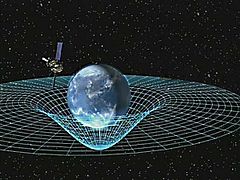| Part of a series on |
| Spacetime |
|---|
 |

In theoretical physics, the composition of two non-collinear Lorentz boosts results in a Lorentz transformation that is not a pure boost but is the composition of a boost and a rotation. This rotation is called Thomas rotation, Thomas–Wigner rotation or Wigner rotation. If a sequence of non-collinear boosts returns an object to its initial velocity, then the sequence of Wigner rotations can combine to produce a net rotation called the Thomas precession.[1]
The rotation was discovered by Émile Borel in 1913,[2][3][4] rediscovered and proved by Ludwik Silberstein in his 1914 book 'Relativity', rediscovered by Llewellyn Thomas in 1926,[5] and rederived by Wigner in 1939.[6] Wigner acknowledged Silberstein.
There are still ongoing discussions about the correct form of equations for the Thomas rotation in different reference systems with contradicting results.[7] Goldstein:[8]
- The spatial rotation resulting from the successive application of two non-collinear Lorentz transformations have been declared every bit as paradoxical as the more frequently discussed apparent violations of common sense, such as the twin paradox.
Einstein's principle of velocity reciprocity (EPVR) reads[9]
- We postulate that the relation between the coordinates of the two systems is linear. Then the inverse transformation is also linear and the complete non-preference of the one or the other system demands that the transformation shall be identical with the original one, except for a change of v to −v
With less careful interpretation, the EPVR is seemingly violated in some situations,[10] but on closer analysis there is no such violation.
Let it be u the velocity in which the lab reference frame moves respect an object called A and let it be v the velocity in which another object called B is moving, measured from the lab reference frame. If u and v are not aligned, the coordinates of the relative velocities of these two bodies will not be opposite even though the actual velocity vectors themselves are indeed opposites (with the fact that the coordinates are not opposites being due to the fact that the two travellers are not using the same coordinate basis vectors).
If A and B both started in the lab system with coordinates matching those of the lab and subsequently use coordinate systems that result from their respective boosts from that system, then the velocity that A will measure on B will be given in terms of A's new coordinate system by:
And the velocity that B will measure on A will be given in terms of B's coordinate system by:
The Lorentz factor for the velocities that either A sees on B or B sees on A are the same:
but the components are not opposites - i.e.
However this does not mean that the velocities are not opposites as the components in each case are multiplied by different basis vectors (and all observers agree that the difference is by a rotation of coordinates such that the actual velocity vectors are indeed exact opposites).
The angle of rotation can be calculated in two ways:
Or:
And the axis of rotation is:
- ^ Rhodes & Semon 2005
- ^ É. Borel, Comptes Rendus 156(3), 215 (1913).
- ^ É. Borel, Comptes Rendus 157(17), 703 (1913).
- ^ Malykin, G. B. (2013-02-01). "A Method of É. Borel for calculation of the Thomas precession: The geometric phase in relativistic kinematic velocity space and its applications in optics". Optics and Spectroscopy. 114 (2): 266–273. Bibcode:2013OptSp.114..266M. doi:10.1134/S0030400X13020197. ISSN 1562-6911.
- ^ Thomas 1926
- ^ Wigner 1939
- ^ Rebilas 2013
- ^ Goldstein 1980, p. 287
- ^ Einstein 1922
- ^ Mocanu 1992

![{\displaystyle \mathbf {v} _{AB}={\frac {1}{1+{\frac {\mathbf {u} \cdot \mathbf {v} }{c^{2}}}}}\left[\left(1+{\frac {1}{c^{2}}}{\frac {\gamma _{\mathbf {u} }}{1+\gamma _{\mathbf {u} }}}\mathbf {u} \cdot \mathbf {v} \right)\mathbf {u} +{\frac {1}{\gamma _{\mathbf {u} }}}\mathbf {v} \right],}](https://wikimedia.org/api/rest_v1/media/math/render/svg/dddbf1fcb780f3a269d5fb934d82b58bbe187107)
![{\displaystyle \mathbf {v} _{BA}={\frac {1}{1+{\frac {\mathbf {v} \cdot \mathbf {u} }{c^{2}}}}}\left[\left(1+{\frac {1}{c^{2}}}{\frac {\gamma _{\mathbf {v} }}{1+\gamma _{\mathbf {v} }}}\mathbf {v} \cdot \mathbf {u} \right)\mathbf {v} +{\frac {1}{\gamma _{\mathbf {v} }}}\mathbf {u} \right],}](https://wikimedia.org/api/rest_v1/media/math/render/svg/f3b29350187c7bd8e1679de3c401bcbb201715a0)




